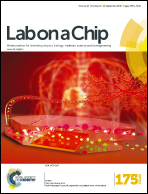Magnetic force-assisted self-locking metallic bead array for fabrication of diverse concave microwell geometries†
Abstract
Spheroid cell culture is very useful for further understanding cellular behavior including motility and biochemical reaction since it mimics three-dimensional (3D) in vivo organ tissue. Among previously proposed various methods for spheroid production, such as hanging drop and spinner flask, microwell is a recently developed method harnessing microtechnology to produce uniform-sized spheroids. Although soft-lithography has been popular for creating microwell arrays, a 3D spherical geometry has been regarded as difficult to fabricate using conventional methods, or often requires complex fabrication processes and expensive equipment. Here, we propose a new method for fabricating concave microwells for cell spheroid production and culture. To demonstrate this method, we fabricated a 30 × 30 microwell array in 3 × 3 cm plates, utilizing metal beads, a through-hole array, and an assembly of small magnets. The spherical metal beads were used as a mold for the microwell, naturally creating the desired 3D concave microwell geometry. One of the key ideas was to place and hold each metal bead in the designated through-hole using the small magnet array. We also performed computational simulation of the magnetostatic force to design and observe the magnetic force field in detail. In addition, to provide a practical demonstration of the proposed system in cell biology, we created and cultured adipose-derived stem cell spheroids for 14 days for chondrogenic differentiation. This method allows further variations in microwell geometry that will enhance the method's applicability as a helpful tool for various studies in cell biology, cancer research, and tissue engineering.


 Please wait while we load your content...
Please wait while we load your content...